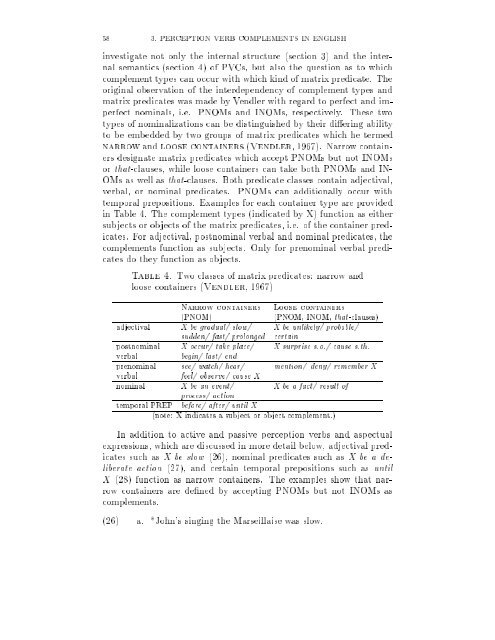Perception verb complements in Akatek, a Mayan language
Perception verb complements in Akatek, a Mayan language
Perception verb complements in Akatek, a Mayan language
Create successful ePaper yourself
Turn your PDF publications into a flip-book with our unique Google optimized e-Paper software.
58 3. PERCEPTION VERB COMPLEMENTS IN ENGLISH<br />
<strong>in</strong>vestigate not only the <strong>in</strong>ternal structure (section 3) and the <strong>in</strong>ternal<br />
semantics (section 4) of PVCs, but also the question as to which<br />
complementtypes can occur with which k<strong>in</strong>d of matrix predicate. The<br />
orig<strong>in</strong>al observation of the <strong>in</strong>terdependency of complement types and<br />
matrix predicates was made by Vendler with regard to perfect and imperfect<br />
nom<strong>in</strong>als, i.e. PNOMs and INOMs, respectively. These two<br />
types of nom<strong>in</strong>alizations can be dist<strong>in</strong>guished by their di er<strong>in</strong>g ability<br />
to be embedded by two groups of matrix predicates which he termed<br />
narrow and loose conta<strong>in</strong>ers (Vendler, 1967). Narrow conta<strong>in</strong>ers<br />
designate matrix predicates which accept PNOMs but not INOMs<br />
or that-clauses, while loose conta<strong>in</strong>ers can take both PNOMs and IN-<br />
OMs as well as that-clauses. Both predicate classes conta<strong>in</strong> adjectival,<br />
<strong>verb</strong>al, or nom<strong>in</strong>al predicates. PNOMs can additionally occur with<br />
temporal prepositions. Examples for each conta<strong>in</strong>er type are provided<br />
<strong>in</strong> Table 4. The complement types (<strong>in</strong>dicated by X) function as either<br />
subjects or objects of the matrix predicates, i.e. of the conta<strong>in</strong>er predicates.<br />
For adjectival, postnom<strong>in</strong>al <strong>verb</strong>al and nom<strong>in</strong>al predicates, the<br />
<strong>complements</strong> function as subjects. Only for prenom<strong>in</strong>al <strong>verb</strong>al predicates<br />
do they function as objects.<br />
Table 4. Two classes of matrix predicates: narrow and<br />
loose conta<strong>in</strong>ers (Vendler, 1967)<br />
Narrow conta<strong>in</strong>ers Loose conta<strong>in</strong>ers<br />
(PNOM) (PNOM, INOM, that-clauses)<br />
adjectival Xbegradual/ slow/ Xbe unlikely/ probable/<br />
sudden/ fast/ prolonged certa<strong>in</strong><br />
postnom<strong>in</strong>al Xoccur/ take place/ X surprise s.o./ cause s.th.<br />
<strong>verb</strong>al beg<strong>in</strong>/ last/ end<br />
prenom<strong>in</strong>al see/ watch/ hear/ mention/ deny/ remember X<br />
<strong>verb</strong>al feel/ observe/ cause X<br />
nom<strong>in</strong>al Xbe an event/ Xbe a fact/ result of<br />
process/ action<br />
temporal PREP before/ after/ until X<br />
(note: X <strong>in</strong>dicates a subject or object complement.)<br />
In addition to active and passive perception <strong>verb</strong>s and aspectual<br />
expressions, which are discussed <strong>in</strong> more detail below, adjectival predicates<br />
such asXbe slow (26), nom<strong>in</strong>al predicates such asXbe a deliberate<br />
action (27), and certa<strong>in</strong> temporal prepositions such asuntil<br />
X (28) function as narrow conta<strong>in</strong>ers. The examples show that narrow<br />
conta<strong>in</strong>ers are de ned by accept<strong>in</strong>g PNOMs but not INOMs as<br />
<strong>complements</strong>.<br />
(26) a. *John's s<strong>in</strong>g<strong>in</strong>g the Marseillaise was slow.

















